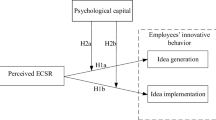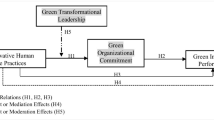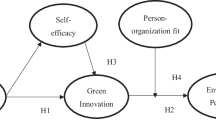Abstract
Purpose
This study examined the mediating role of perceived organizational support (POS) in the relationship between group-incentive participation and organizational commitment. The study also investigated the moderating role of innovation in the relationship between group-incentive participation and POS and the relationship between group-incentive participation and organizational commitment.
Design/Methodology/Approach
The proposed hypotheses were tested by hierarchical linear modeling by means of survey data that were collected in South Korea in 2008.
Findings
The results showed that the relationship between group-incentive participation and organizational commitment was fully mediated by POS. Cross-level analyses revealed that group-incentive participation had stronger relationships with POS and organizational commitment in more innovative companies than in less innovative companies.
Implications
These findings contribute to the literature by identifying the characteristics of organizations in which group-incentive participation is more effective. In particular, innovative companies could benefit from adopting group-incentive practices because these practices are more strongly related to POS and organizational commitment in more innovative companies.
Originality/Value
Whereas previous studies on group incentives have mainly focused on the effects of group incentives at the organizational level, this study bridged the gap between macro- and microapproaches through multilevel analyses. This study is unique in that it examined the vertical fit between group incentives and organizational characteristics while focusing on individual employees’ perceptions and attitudes.



Similar content being viewed by others
References
Aiken, L. S., & West, S. G. (1991). Multiple regression: Testing and interpreting interactions. Thousand Oaks, CA: SAGE.
Allen, D. G., Shore, L. M., & Griffeth, R. W. (2003). The role of perceived organizational support and supportive human resource practices in the turnover process. Journal of Management, 29(1), 99–118.
Amabile, T. M. (1988). A model of creativity and innovation in organizations. In B. M. Staw & L. L. Cummings (Eds.), Research in organizational behavior (pp. 187–209). Greenwich, CT: JAI Press.
Anderson, E., & Oliver, R. L. (1987). Perspectives on behavior-based versus outcome-based salesforce control systems. Journal of Marketing, 51, 76–88.
Appelbaum, E., Baily, T., Berg, P., & Kalleberg, A. L. (2000). Manufacturing advantage: Why high performance work systems pay off. Ithaca, NY: Cornell University Press.
Arthur, J. B., & Huntley, C. L. (2005). Ramping up the organizational learning curve: Assessing the impact of deliberate learning on organizational performance under gainsharing. Academy of Management Journal, 48(6), 1159–1170.
Banker, R. D., Lee, S. Y., Potter, G., & Srinivasan, D. (1996). Contextual analysis of performance impacts of outcome-based incentive compensation. Academy of Management Journal, 39(4), 920–948.
Bauer, D. J., Preacher, K. J., & Gil, K. M. (2006). Conceptualizing and testing random indirect effects and moderated mediation in multilevel models: New procedures and recommendations. Psychological Methods, 11(2), 142–163.
Blakely, G. L., Andrews, M. C., & Fuller, J. (2003). Are chameleons good citizens? A longitudinal study of the relationship between self-monitoring and organizational citizenship behavior. Journal of Business and Psychology, 18(2), 131–144.
Bolton, M. K. (1993). Organizational innovation and substandard performance: When is necessity the mother of innovation? Organization Science, 4(1), 57–75.
Bryk, A. S., & Raudenbush, S. W. (1992). Hierarchical linear models. Newbury Park, CA: SAGE.
Cappelli, P., & Neumark, D. (2001). Do “high-performance” work practices improve establishment-level outcomes? Industrial and Labor Relations Review, 54(4), 737–775.
Cooke, W. N. (1994). Employee participation programs, group-based incentives, and company performance: A union-nonunion comparison. Industrial and Labor Relations Review, 47, 594–609.
Coyle-Shapiro, J., Morrow, P. C., Richardson, R., & Dunn, S. R. (2002). Using profit sharing to enhance employee attitudes: A longitudinal examination of the effects on trust and commitment. Human Resource Management, 41(4), 423–439.
Cravens, D. W., Ingram, T. N., LaForge, R. W., & Young, C. E. (1993). Behavior-based and outcome-based salesforce control systems. Journal of Marketing, 57, 47–59.
Daft, R., & Becker, S. (1978). Innovation in organization. New York: Elsevier.
Damanpour, F. (1996). Organizational complexity and innovation: Developing and testing multiple contingency models. Management Science, 42(5), 693–716.
Damanpour, F., Walker, R. M., & Avellaneda, C. N. (2009). Combinative effects of innovation types and organizational performance: A longitudinal study of service organizations. Journal of Management Studies, 46(4), 650–675.
Deci, E. L., Connell, J. P., & Ryan, R. M. (1989). Self-determination in a work organization. Journal of Applied Psychology, 74, 580–590.
Deci, E. L., & Ryan, R. M. (2000). The “what” and the “why” of goal pursuits: Human needs and the self-determination of behavior. Psychological Inquiry, 11, 227–268.
Delery, J. E., & Doty, D. H. (1996). Modes of theorizing in strategic human resource management: Tests of universalistic, contingency, and configurational performance predictions. Academy of Management Journal, 39(4), 802–835.
Diaz, M. D., & Gomez-Mejia, L. R. (1997). The effectiveness of organization-wide compensation strategies in technology intensive firms. Journal of High Technology Management Research, 8(2), 301–315.
Donaldson, S. I., & Grant-Vallone, E. J. (2002). Understanding self-report bias in organizational behavior research. Journal of Business and Psychology, 17(2), 245–260.
Dougherty, D. (1992). A practice-centered model of organizational renewal through product innovation. Strategic Management Journal, 13, 77–92.
Dulebohn, J. H., & Martocchio, J. J. (1998). Employee perceptions of the fairness of work group incentive pay plans. Journal of Management, 24(4), 469–488.
Edwards, J. R., & Lambert, L. S. (2007). Methods for integrating moderation and mediation: A general analytical framework using moderated path analysis. Psychological Methods, 12(1), 1–22.
Eisenberger, R., Armeli, S., Rexwinkel, B., Lynch, P. D., & Roades, L. (2001). Reciprocation of perceived organizational support. Journal of Applied Psychology, 86(1), 42–51.
Eisenberger, R., Fasolo, P., & Davis-LaMastro, V. (1990). Perceived organizational support and employee diligence, commitment, and innovation. Journal of Applied Psychology, 75(1), 51–59.
Eisenberger, R., Huntington, R., Hutchison, S., & Sowa, D. (1986). Perceived organizational support. Journal of Applied Psychology, 71(3), 500–507.
Eisenberger, R., Rhoades, L., & Cameron, J. (1999). Does pay for performance increase or decrease perceived self-determination and intrinsic motivation? Journal of Personality and Social Psychology, 77(5), 1026–1040.
Enders, C. K., & Tofighi, D. (2007). Centering predictor variables in cross-sectional multilevel models: A new look at an old issue. Psychological Methods, 12(2), 121–138.
Fernie, S., & Metcalf, D. (1995). Participation, contingent pay, representation and workplace performance: Evidence from Great Britain. British Journal of Industrial Relations, 33(3), 380–415.
Gomez-Mejia, L. R., & Balkin, D. B. (1992). Compensation, organizational strategy, and firm performance. Cincinnati: South-Western Publishing Company.
Goodman, R. K., & Moore, B. E. (1976). Factors affecting acquisition of beliefs about a reward system. Human Relations, 29(6), 571–588.
Hanlon, S. C., & Taylor, R. R. (1991). An examination of changes in work group communication behaviors following installation of a gainsharing plan. Group and Organization Studies, 16, 238–267.
Hofmann, D. A. (1997). An overview of the logic and rationale of hierarchical linear models. Journal of Management, 23(6), 723–744.
Hofmann, D. A., & Gavin, M. B. (1998). Centering decisions in hierarchical linear models: Implications for research in organizations. Journal of Management, 24(5), 623–641.
Hollensbe, E. C., & Guthrie, J. P. (2000). Group pay-for-performance plans: The role of spontaneous goal setting. Academy of Management Review, 25(4), 864–872.
Ichniowski, C., Shaw, K., & Prennushi, G. (1997). The effects of human resource management practices on productivity: A study of steel finishing lines. The American Economic Review, 87(3), 291–313.
Jackson, S. E., Schuler, R. S., & Rivero, J. C. (1989). Organizational characteristics as predictors of personnel practices. Personnel Psychology, 42, 727–786.
James, J. R. (1982). Aggregation bias in estimates of perceptual agreement. Journal of Applied Psychology, 67, 219–229.
Jenkins, G. D., Mitra, A., Gupta, N., & Shaw, J. D. (1998). Are financial incentives related to performance? A meta-analytic review of empirical research. Journal of Applied Psychology, 83(5), 777–787.
Kaufman, R. T. (1992). The effects of improshare on productivity. Industrial and Labor Relations Review, 45(2), 311–322.
Kerin, R., Mahajan, V., & Varadarajan, P. (1990). Contemporary perspectives on strategic market planning. Boston: Allyn and Bacon.
Kruse, L. D. (1993). Profit sharing: Does it make a difference?. Kalamazoo, MI: W.E. Upjohn Institute for Employment Research.
Kwon, S., Kim, M. S., Kang, S., & Kim, M. U. (2008). Employee reactions to gainsharing under seniority pay systems: The mediating effect of distributive, procedural, and interactional justice. Human Resource Management, 47(4), 757–775.
Locke, E. A., & Latham, G. P. (2002). Building a practically useful theory of goal setting and task motivation. American Psychologist, 57(9), 705–717.
MacDuffie, J. P. (1995). Human resource bundles and manufacturing performance: Organizational logic and flexible production systems in the world auto industry. Industrial and Labor Relations Review, 48, 197–221.
Magnan, M., & St-Onge, S. (2005). The impact of profit sharing on the performance of financial services firms. Journal of Management Studies, 42(4), 761–791.
Mathieu, J. E., & Zajac, D. M. (1990). A review and metal-analysis of the antecedents, correlates, and consequences of organizational commitment. Psychological Bulletin, 108, 171–194.
Miles, R. E., & Snow, C. C. (1984). Designing strategic human resources systems. Organizational Dynamics, 13(1), 36–52.
Miles, R., Snow, C., Meyer, A., & Coleman, H. (1978). Organizational strategy, structure, and process. Academy of Management Review, 3(3), 546–562.
Milkovich, G. T. (1988). A strategic perspective on compensation management. In K. Rowland & G. Ferris (Eds.), Research in personnel and human resources management. Greenwich, CT: JAI Press.
Monge, P. R., Cozzens, M. D., & Contractor, N. S. (1992). Communication and motivational predictors of the dynamics of organizational innovation. Organization Science, 3(2), 250–274.
Mowday, R., Steers, R., & Porter, L. (1979). The measurement of organizational commitment. Journal of Vocational Behavior, 14, 224–247.
Muller, D., Judd, C. M., & Yzerbyt, V. Y. (2005). When moderation is mediated and mediation is moderated. Journal of Personality and Social Psychology, 89(6), 852–863.
Mumford, M. D. (2000). Managing creative people: Strategies and tactics for innovation. Human Resource Management Review, 10, 313–351.
Neal, A., West, M. A., & Patterson, M. G. (2005). Do organizational climate and competitive strategy moderate the relationship between human resource management and productivity? Journal of Management, 31(4), 492–512.
Park, R. (2012). Cognitive and affective approaches to employee participation: Integration of the two approaches. Journal of World Business, 47, 450–458.
Park, R., Appelbaum, E., & Kruse, D. (2010). Employee involvement and group incentives in manufacturing companies: A multi-level analysis. Human Resource Management Journal, 20(3), 227–243.
Parker, S. K. (2003). Longitudinal effects of lean production on employee outcomes and the mediating role of work characteristics. Journal of Applied Psychology, 88(4), 620–634.
Peterson, S. J., & Luthans, F. (2006). The impact of financial and nonfinancial incentives on business-unit outcomes over time. Journal of Applied Psychology, 91(1), 156–165.
Porter, M. E. (1980). Competitive strategy. New York: Free Press.
Preacher, K. J., Curran, P. J., & Bauer, D. J. (2004). Simple intercepts, simple slopes, and regions of significance in HLM 2-way interactions. http://people.ku.edu/~preacher/interact/hlm2.htm. Accessed 10 June 2011.
Raudenbush, S., & Bryk, A. S. (2002). Hierarchical linear models: Applications and data analysis methods. Thousand Oaks, CA: SAGE.
Rhoades, L., & Eisenberger, R. (2002). Perceived organizational support: A review of the literature. Journal of Applied Psychology, 87(4), 698–714.
Rhoades, L., Eisenberger, R., & Armeli, S. (2001). Affective commitment to the organization: The contribution of perceived organizational support. Journal of Applied Psychology, 86(5), 825–836.
Richard, O., McMillan, A., Chadwick, K., & Dwyer, S. (2003). Employing an innovation strategy in racially diverse workforces. Group & Organization Management, 28(1), 107–126.
Schuler, R. S., & Jackson, S. E. (1987). Linking competitive strategies with human resource management practices. Academy of Management Executive, 1(3), 207–219.
Shore, L. M., & Barksdale, K. (1998). Examining degree of balance and level of obligation in the employment relationship: A social exchange approach. Journal of Organizational Behavior, 19, 731–744.
Stevens, J. M., Beyer, J., & Trice, H. M. (1978). Assessing personal, role, and organizational predictors of managerial commitment. Academy of Management Journal, 21, 380–396.
Tremblay, M., & Chenevert, D. (2008). Influence of compensation strategies in Canadian technology-intensive firms on organizational and human resources performance. Group & Organization Management, 33(3), 269–302.
Van De Ven, A. H. (1986). Central problems in the management of innovation. Management Science, 32(5), 590–607.
Wayne, S. J., Shore, L. M., & Liden, R. C. (1997). Perceived organizational support and leader-member exchange: A social exchange perspective. Academy of Management Journal, 40, 82–111.
Welbourne, T. M., Balkin, D. B., & Gomez-Mejia, L. R. (1995). Gainsharing and mutual monitoring: A combined agency-organizational justice interpretation. Academy of Management Journal, 38(3), 881–899.
Whitener, E. M. (2001). Do “high commitment” human resource practices affect employee commitment? A cross-level analysis using hierarchical linear modeling. Journal of Management, 27, 515–535.
Woodman, R. W., Sawyer, J. E., & Griffin, R. W. (1993). Toward a theory of organizational creativity. Academy of Management Review, 18, 293–321.
Youndt, M. A., Dean, J. W., & Lepak, D. P. (1996). Human resource management, manufacturing strategy, and firm performance. Academy of Management Journal, 39(4), 836–866.
Zhang, Z., Zyphur, M. J., & Preacher, K. J. (2009). Testing multilevel mediation using hierarchical linear models: Problems and solutions. Organizational Research Methods, 12(4), 695–718.
Acknowledgments
The present research has been conducted by the Research Grant of Kwangwoon University in 2012.
Author information
Authors and Affiliations
Corresponding author
Rights and permissions
About this article
Cite this article
Park, R., Kim, J. Individual Employees’ Responses to Group Incentives: The Moderating Role of Innovation. J Bus Psychol 28, 175–187 (2013). https://doi.org/10.1007/s10869-012-9270-9
Published:
Issue Date:
DOI: https://doi.org/10.1007/s10869-012-9270-9




